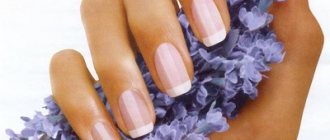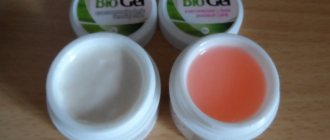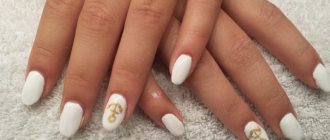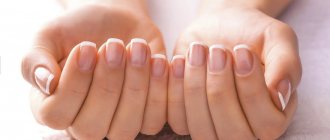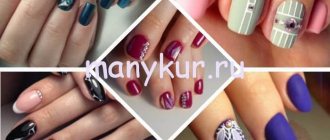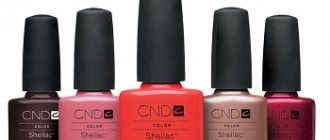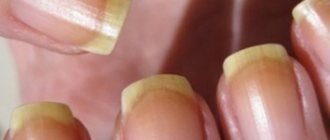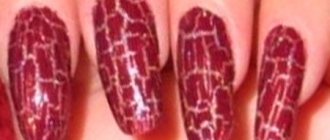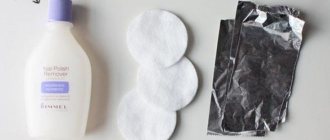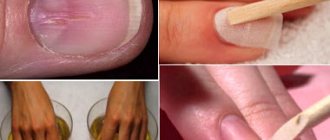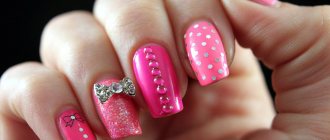What is camouflage nail base?
The composition serves as a base layer for applying the finishing coat. Camouflage comes in different consistencies and shade palettes. Pastel colors are often used because they best match the natural color of human skin. Thanks to this, the modeled nail plate looks as naturalistic as possible.
Natural tones:
- universal;
- always relevant;
- fit perfectly into any dress code;
- fit well with various outfits.
This is the best option for girls with thin and flaky nails. With its structure and density, the camouflage cosmetic composition resembles a natural nail plate. This manicure looks as naturalistic as possible.
The camouflage is polymerized under the influence of an ultraviolet lamp or LED radiation. The nail extension procedure does not take much time and does not require special skills.
The naturalness of a nude manicure based on a camouflage base allows you to successfully combine it with fashionable wardrobe items and accessories, and the variety of body colors allows you to choose a shade to match the color of the skin of your hands and face.
The composition forms a thin and durable polymer film with increased adhesive properties on the nail plate. It is great for doing your own extensions and creating a flawless manicure at home.
The viscous material makes the nail plate absolutely smooth. It provides air access to tissues, preventing the development of fungal microflora and the occurrence of an inflammatory process in the most sensitive area of women's hands.
Benefits of camouflage gel
This method of extension has its advantages:
- Nails have a perfect glossy surface.
- The camouflage gel contains substances that prevent the occurrence of fungal diseases in the nail area.
- The gel is able to strengthen the “native” nail and make it smoother.
- Camouflage nail gel is breathable.
- It looks very natural and is almost indistinguishable from natural nails.
- You can walk with nails extended with camouflage gel for a long time
What is camouflage used for?
Nude manicure based on rubber, acrylic or silicone is used to lengthen and strengthen the nail plate, disguise aesthetic flaws and anatomical defects. In a three-stage system, camouflage serves as the foundation on which the gel polish rests. Therefore, increased demands are placed on its strength and reliability.
The camouflage base (what kind of polymer it is is a separate question of choosing a product) can be acrylic, silicone or rubber. It can be made nude, pastel or transparent. The last option is used when creating an artistic French manicure - a French manicure.
The main purposes of camouflage:
- nail plate modeling;
- improvement of its anatomical structure;
- correction and masking of various defects;
- creating a durable base for applying gel polish;
- increasing the durability of manicure;
- protection of fabrics from the harmful effects of chemically aggressive coloring pigments;
An important function of the polymer foundation is to level the surface to distribute the finishing layer.
Camouflage gives destructive nail plates with microcracks, tubercles, and other aesthetic defects a uniform texture. On such a surface, the manicure retains its original appearance longer than usual. In addition, the base thickens the nail plate and makes it stronger.
Often nude camouflage is used for gel polish coating with:
- shimmer;
- sparkles;
- silver plating;
- original mirror or futuristic titanium effect.
The polymer base performs a healing function, resuscitating and restoring the natural structure of the nail plate after removing a chemically aggressive colored manicure. Its formula has a beneficial effect on the surrounding skin.
Camouflage properties
Initially, the product was created for the correction of natural nail plates and their lengthening during artificial manicure. The material lay down so smoothly and held firmly that the craftsmen began to think about whether it was possible to extend nails with camouflage gel . The first experiments confirmed the suitable properties and decent results:
- the extended plates look almost like “native” ones;
- the growing nail is masked for a long time and the free edge is covered;
- the extension technique is available to those with nails with a small, irregularly shaped bed;
- effective camouflage gel for strengthening and smoothing nails ;
- it contains antifungal and antiseptic substances;
- The frozen camouflage gel allows air to pass through: the nails “breathe”, the metabolic processes of the nail bed and the replenishment of the plate are not disrupted.
It retains its presentable appearance almost until the coating is removed, and this manicure is worn for at least 3 weeks. True, a strong build-up with camouflage gel can only be removed by cutting off the coating. But for this there are soft cutters and gentle technologies that protect the structure of the natural plate.
Application Features
To create a flawless manicure based on camouflage, a special coating technology is used. Gel polish applied in this way lasts a long time, without chipping, peeling, or scratching. In salons, masters pre-prepare the nail plate for the procedure.
The camouflage base (what it is and the sequence of actions for application are described in the instructions that come with the manicure composition) is applied only to a cleaned and degreased surface. Professional training is carried out using a special apparatus.
With its help, they eliminate impurities, remove the cuticle, and remove dead fragments of the epidermis surrounding the nail plate. At home, you can use the accessories of a manicure set - tongs, a regular nail file, and a sanding buffer.
A primer is applied to the treated surface. When decorating the nail plate with a camouflage polymer, you can use a composition of a dark shade to create. expressive boundary between the bed and the edge contours.
In the fashion trends of French manicure, a polymer base of a three-layer design is used in conjunction with gel polish of a delicate milky shade. In case of severe destruction of the nail plate, it is advisable to use camouflage of the most dense consistency with a high viscosity index.
What do you need to apply biogel nail extensions?
The materials required for nail extensions with biogel are a special biogel, as well as a list of the following tools and products:
- Nail file and grinder for processing the nail plate;
- Brush for removing dust formed after filing nails;
- Set of orange sticks;
- Brushes for applying gel;
- Primer used as a primer layer;
- Means for degreasing the nail plate;
- Single-color biogel for nails, as well as biogels for decoration;
- Top coating;
- Polisher for artificial nails;
- Ultraviolet lamp (preferably with a power of 36 W).
The purchase of these materials makes it possible to apply biogel nail extensions at home. The same list of materials is used by the master working in the salon. Doing your own nail extensions is a rather complicated procedure that requires training from a professional master and some experience, with which you can increase the density of your nails and give them the desired shape without risking the health of your own nails.
Types of Camouflage Gel
There are 3 phases of the masking polymer base. Each type has its own purpose and is used for different types of nail plates. You need to select the base individually, depending on the desired effect.
The phases are different:
- consistency;
- chemical properties;
- physical and mechanical characteristics;
- provided by the application technology.
All of them perform a leveling function and ensure reliable adhesion of the gel polish to the surface of the nail plate.
1-phase
This is the most commonly used and easiest to apply polymer manicure base.
This composition is usually transparent in color, of medium thickness and viscosity, and does not bubble.
It polymerizes quickly when exposed to ultraviolet radiation.
Once completely dry, it can be easily given the desired shape by filing or polishing.
A 1-phase type camouflage base ensures reliable adhesion of the nail plate to subsequent layers.
What does it give:
- manicure lasts a long time;
- is highly resistant to external factors;
- has an impeccably aesthetic appearance;
- Easy to apply gel polish with shimmer, glitter, silver effect.
This acrylic or silicone base can be used to create a uniform matte or glossy finish and form any image.
2-phase
This type of camouflage base has a thinner consistency, making it a little easier to work with. It is used for nail extensions while simultaneously strengthening them. 2-phase camouflage is applied to an architectural base coat to give the manicure the most natural look. This base is applied in 3 layers.
Each of them has its own functional purpose:
- 1st – ensures reliable adhesion of the gel polish to the nail surface;
- 2nd – corrects anatomical errors of the plate;
- 3rd – consolidates the leveling effect.
This polymer is not very popular because it does not give as durable a result as the previous option.
3-phase
These camouflage bases are the most liquid. The composition quickly spreads over the surface of the nail. The 3-phase base is applied in an extremely thin layer. To thicken the nail plate, successive repeated applications are required after the lower tier has dried.
Due to its liquid consistency, this composition is prone to the formation of bubbles. To avoid this undesirable effect, the polymer is distributed over the surface of the nail slowly, carefully, thoroughly.
Creating a manicure based on a 3-phase camouflage base takes a lot of time. But the result is excellent. This coating is not afraid of mechanical stress.
What is camouflage gel?
It is an opaque gel that is close in color to natural beige/pink/nude. Designed for laying on the surface of the nail plate and creating an artificial nail. The right shade of camouflage gel hides the transition between the nail bed and the free edge, especially as it grows out. For those who genetically have a short nail bed, beige polymer helps correct shortcomings, turning them into advantages. Lengthening is simply necessary, because from an aesthetic point of view, the free edge should not exceed the length of the nail bed.
French manicure is considered the closest to natural manicure. It is an imitation of a natural nail - a smile line is formed on the grown part with white gel, and camouflage gel is laid out on the remaining nail plate (also called camouflage). This polymer has a whole range of shades (natural pink color), and therefore it can be matched to the color of natural nails. Many masters use camouflage gel to give the client’s nail plate a smooth finish.
Modeling using tips and forms for extensions is also not complete without beige polymers. They are used to create a constructive layer (for shape and volume), a tinting layer (to smooth out the color transition from natural to artificial nails) and as a base for the finish.
Advantages and disadvantages
The camouflage base gives the nail plate anatomical perfection, high strength, and absolute smoothness. The list of advantages of the polymer base is not limited to this.
Some of the important advantages of such a multi-layer manicure include:
- strengthening weakened and damaged nails;
- the content of special biologically active components that prevent fungal infection and the development of the inflammatory process;
- a unique polymer coating formula that ensures free penetration of the atmospheric mixture into fabrics;
- long service life of the cosmetic coating;
- natural look;
The camouflage base (what it is and what its features are described in the article) does not allow the multilayer coating to delaminate. It is ideal for fans of fashionable French manicure - French. Polymer material is not without a number of disadvantages.
The most significant of them:
- the high price of a camouflage base, extension procedures and aesthetic correction of nail plates;
- the need to re-manicure monthly;
- some components of such compositions can cause allergic reactions;
- If the application technology is not followed, you can damage your nails;
Improper use of a UV lamp results in microscopic burns to the skin. One of the disadvantages of this manicure is the duration of the nail extension process.
Strengthening
The material is environmentally friendly, does not contain benzene, acetone, plastics, acrylic acid, etc., it can be used if you are prone to allergies. Strengthening nails with this composition is not contraindicated during pregnancy.
The main property of biogel is to nourish and strengthen the nail plate, so it can be used to restore or treat nails after extensions with other materials. It will also help with brittle nails, and make healthy ones even stronger.
It promotes the growth of strong natural nails by allowing them to breathe.
Back to Contents
Camouflage base color
The modern beauty industry is trying to reach the widest possible range of consumer audiences. Therefore, manufacturers produce camouflage compositions for any color type of appearance and skin tone.
The following colors are ideal for dark-skinned girls:
- beige;
- apricot;
- peach;
- nude;
- pale pink.
They create the most expressive color contrast. For those with fair skin, it makes sense to give preference to a translucent composition, ivory or tea rose.
By varying the thickness and saturation of the polymer coating available, you can create unique colors of the camouflage base for gel polish with shimmer, shiny inclusions, and a silver effect.
The manicure base in the rare shade of Ivory Idy, a delicate creamy color, looks very expressive on sultry brunettes.
The most unusual colors of commercially produced nude camouflages:
- "languid kiss";
- "almond roast";
- “cream praline”;
- "bold peach"
All of them belong to the palette of flesh tones and represent a darkened or lightened variation of the classic beige color of different viscosity and color saturation.
Warm colors (peach, apricot and others) emphasize the graceful glow of a bronze tan or dark skin. Such camouflage bases are relevant for the summer period. A modern classic of the genre is considered a transparent polymer in combination with a French manicure.
A splash of snow-white pigment will add a touch of frosty mood to any girl’s summer look. For silver gel polish, it is advisable to choose a nude base that is close to a yellow-beige color. For a manicure with glitter, a nude camouflage base is perfect, as close as possible to the natural skin tone.
How to make the right choice?
You need to focus not only on the color of the base, but also on other criteria. One of the most important is the type of polymer composition. Rubber-based products are intended for aesthetic correction and modeling of the natural anatomical structure of the nail plate.
This wood resin lays down in an even layer, increases the thickness of the surface, and gives the composition thickness and ductility. Rubber bases are great for smoothing out problem nails. They are recommended for owners of thin and fragile plates. This polymer prevents the formation of microcracks.
A camouflage base (what it is and why it is needed is described in the article) is selected depending on the desired effect and the condition of the nail plates. Manicure compositions based on acrylic powder are popular.
It polymerizes under the influence of ultraviolet radiation and forms a thin but very durable film. Then another layer is applied, thoroughly polished, and only then gel polish with shimmer, glitter, silver or another effect is applied.
The tandem of an acrylic camouflage base with a finishing coat forms a durable nail frame. It prevents the plate from delaminating and ensures the durability of the manicure. Its only significant drawback is the difficulty of removal.
A silicone base is also often used. It is produced both in a gel-like state and in the form of stickers. The first option is chosen for flawless leveling of the damaged nail plate. Gel-like silicone has good sealing properties and a viscous consistency.
Stickers are suitable for those who want to restore the natural shape of their nails or lengthen them. This base does not require polymerization and can be easily removed. The most breathable coating is created by a water-based liquid camouflage base. Its main disadvantage is the fragility of the manicure.
What is camouflage gel?
This type of gel, like conventional polymers, comes in three types: one-, two- and three-phase. Why were so many varieties created?
Single-phase camouflage gel is a polymer that provides better adhesion of artificial material to natural coating. It dries within 3-5 minutes (depending on the ingredients) and is easy to file. In terms of external characteristics, the polymer has a thick consistency, due to which it creates a better shape, but is more difficult to lay out on the stock. Due to its density, the nail gel does not bubble. This has a positive effect on the subsequent design of the nail plate.
Method of using single-phase material:
- Initially, the natural surface is degreased.
- A primer is applied to it.
- The nail plate is covered with a thin layer of camouflage gel (base strip). Polymerization in a lamp takes up to 2 minutes.
- Apply 2nd layer of camouflage - constructive.
- After removing the stickiness with a degreaser, the nail is coated with a glass-shine finish.
Among the manufacturers of single-phase camouflage gel are Masque Apricot Gel, Masque Peach Gel, Pink Gel, Masque Suntan Gel, etc. Very often, extension specialists use polymers from Chinese manufacturers in their work to save money. Sometimes this affects the quality of artificial nails, and therefore be careful about the material from which company will decorate your nails.
Two-phase has a medium consistency. To create a better effect and better design, a less dense polymer is more convenient. It can be applied in 2-3 layers. The polymer is used according to the single-phase principle. It is applied in several layers: base, sculptural and finishing.
The first strip of gel creates a strong adhesion between the natural surface of the nail and the artificial material. This is the base layer. Apply it in a thin layer. The main task of camouflage gel at this stage is to become a conductor between the polymer and the natural nail.
Next comes the sculptural layer. Usually it includes up to three strips of gel (depending on the specialist and his qualifications). At this stage, the shape of the nail bed is formed, the tubercle characteristic of the design of extended nails and a smooth transition to the edge of the plate.
How to use camouflage nail base?
This procedure is carried out mainly in beauty salons. If you follow the technology of applying a camouflage base and gel polish, you can create a flawless manicure at home.
The figure shows the rules for using a camouflage base to straighten nails.
Step-by-step instruction:
- First, prepare the nail plates by cleaning and degreasing them.
- Perform a standard hygienic manicure, removing dust with a soft buff.
- The nails are given the desired shape by filing.
- Then the extension form is applied so that its center coincides with the middle of the native nail plate.
- The template is securely fastened.
- Next, use a brush to grab a small amount of camouflage polymer and distribute it in a thin layer evenly over the entire surface to be treated.
- Polymerize under a UV lamp for 2 minutes.
- Remove the dispersion coating and use a manicure file to give the nail plate streamlined contours.
If the camouflage base is applied in several layers, each of them polymerizes for 2 minutes. after the previous one has completely dried. Upon completion of the process, the template is removed and a fixing gel polish is applied.
Technique for nail extension using camouflage
The extension procedure is carried out mainly in salons, but if you wish and follow all the rules for working with materials and equipment, you can perform extensions at home.
The entire procedure for working with camouflage gel is carried out in several stages:
- We prepare and treat hands and nails, that is, we carry out a standard hygienic manicure.
- Degrease the nail plates.
- Apply primer and cure it in a lamp.
- Next, prepare the artificial form and place it on the nail plate so that the center of the nail coincides with the center of the form.
- We put a certain amount of gel on the brush and distribute it evenly over the surface of the mold, starting from the middle and moving towards the free edge. At this stage, we model the required length and desired shape of the extended free edge.
- The formed fragment is polymerized in a lamp.
- Then we cover the natural plate with base gel and dry it. This is done for better adhesion.
- Apply the base coat again to the fragment and the entire nail, but do not dry it.
- Using a brush, pick up a certain amount of camouflage and place it in the middle of the nail plate. Using even smooth movements of the brush, we distribute it over the entire plate, trying to get no closer than 1 mm to the cuticle and ridges.
- After the material has been laid out on the surface, we place it under the lamp for 15-20 seconds. Then we press the gel with a special clothespin, and again send it to polymerize until completely dry.
- We remove the mold, the sticky layer, file the free edge, and sand the surface with a buff.
- If subsequent design and decoration is not provided, then apply a finishing coat, seal the end and dry in a lamp until the top is completely dry.
You can more clearly familiarize yourself with the technique of modeling and extending nails with camouflage material by watching the video:
Initially, camouflage gels were invented and developed to create the perfect jacket. An example of such a manicure is shown in detail in the video:
With the help of camouflage material, you can carry out not only the process of building up nail plates, but also carry out the procedure for strengthening them. You can learn more about the technique by watching the video:
Review of camouflage nail bases
Polymer compositions from all manufacturers have virtually identical chemical formulas, with the exception of the coloring pigment used. When choosing, you need to make sure that there is no allergic reaction to it.
List of popular camouflage bases for gel polish with shimmer, sparkles, silver:
| Name | Product Description | Volume | Price |
| CND Base Coat | The composition has a dense consistency. Polymerizes in 30 seconds. Compatible with any gel polish coatings. Ideally aligns the nail plate. Often used for gel polishes with shimmer. | 12.5 ml | 1830 rub. |
| Uno, Color Rubber Base | Rubber-based composition. Thanks to its dense texture and increased viscosity, it has good leveling properties. Color – beige with a delicate pink undertone. | 8 ml | 490 rub. |
| Cosmolac Cover Base 01 | Medium consistency camouflage base. Used for leveling, toning, strengthening the nail plate. Polymerization time – 3 min. | 7.5 ml | 240 rub. |
| Kodi Rubber Base | Rubber polymer of viscous consistency. Color – nude. Suitable for any varnish gels. | 7 ml | 450 rub. |
| Klio Professional | Composition of a neutral beige shade on a rubber base. Used to smooth out lumpy nail plates. Has a strengthening effect. Polymerizes under ultraviolet light - 2 minutes, under an LED lamp - 1 minute. | 12 ml | 470 rub. |
| Haruyama Base | Medium thickness camouflage base with a neutral flesh tone. It is well distributed in an even layer over the nail plate. It is popular due to its low price. It is incompatible with colored Chinese gel polishes. | 30 ml | 600 rub. |
| Beautix Royal | Rubber polymer with self-leveling properties. Provides reliable protection against mechanical damage to fragile nails. The universal nude shade allows you to combine it with any gel polishes - shimmer, glitter, silver. | 15 ml | 990 rub. |
The products of the American brand CND are in especially high demand. Such compositions have an optimal consistency. Applying such a polymer composition at home is not difficult.
Materials for strengthening nails with biogel
A set of products for strengthening nails with biogel, which you will need for working at home, includes:
- Directly biogel to strengthen nails;
- A product for degreasing nails and improving the adhesion of the applied material to the surface of the nail;
- Means for removing the sticky layer and cotton pads for applying it;
- A file with an abrasiveness of one hundred to one hundred and eighty grit, as well as a polishing buffer;
- Finishing coating to add shine;
- Brushes for applying gel;
- An ultraviolet lamp in which the gel coating is polymerized;
- Decorative materials (colored varnishes, glitter, foil, rhinestones, paints) as desired.
This set for strengthening nails with biogel is used not only for work at home. It is also used by professionals who strengthen nails in a beauty salon.
How to make a camouflage base with your own hands?
It’s not difficult to make such a manicure product yourself. There is liquid silicone on sale that is quite suitable for this purpose. You can use gel rubber or acrylic powder. This substance is mixed in a small container with regular nail polish of the desired shade.
The result will be a universal camouflage base. Add 2-3 drops of nail polish to 20 ml of polymer substance. You can use a ready-made transparent base, dilute it to the desired consistency and add a coloring pigment of the desired shade. This will give you the opportunity to get a unique color scheme and exclusive texture.
